

A harmonichord is a kind of upright piano in which the strings are set in vibration not by the blow of the hammer but by indirectly transmitted friction. [1]


A harmonichord is a kind of upright piano in which the strings are set in vibration not by the blow of the hammer but by indirectly transmitted friction. [1]
The harmonichord, one of the many attempts to fuse the piano and violin, was invented by Johann Gottfried Kaufmann and Johann Friedrich Kaufmann (father and son) in Saxony at the beginning of the 19th century, when the craze for new and ingenious musical instruments was at its height. [1]
The case was of the variety known as giraffe. The space under the keyboard was enclosed, a knee-hold being left in which were two pedals used to set in rotation a large wooden cylinder fixed just behind the keyboard over the levers, and covered with a roll-top similar to those of modern office desks. The cylinder (in some specimens covered with chamois leather) tapered towards the treble-end. When a key was depressed, a little tongue of wood, one end of which stopped the string, was pressed against the revolving cylinder, and the vibrations produced by friction were transmitted to the string and reinforced as in the piano and violin by the soundboard. The adjustment of the parts and the velocity of the cylinder required delicacy and great nicety, for if the little wooden tongues rested too lightly upon the cylinder or the strings, harmonics were produced, and the note jumped to the octave or twelfth. [1] [2] Sometimes when chords were played the touch became so heavy that two performers were required, as in the early medieval organistrum, the prototype of the harmonichord. Carl Maria von Weber must have had some opinion of the possibilities of the harmonichord, which in tone resembled the glass harmonica, since he composed a concerto with orchestral accompaniment for the instrument. [1]

The cello ( CHEL-oh), or violoncello ( VY-ə-lən-CHEL-oh, Italian pronunciation:[vjolonˈtʃɛllo]), is a bowed (sometimes plucked and occasionally hit) string instrument of the violin family. Its four strings are usually tuned in perfect fifths: from low to high, C2, G2, D3 and A3. The viola's four strings are each an octave higher. Music for the cello is generally written in the bass clef, with tenor clef, and treble clef used for higher-range passages.

The clavichord is a stringed rectangular keyboard instrument that was used largely in the Late Middle Ages, through the Renaissance, Baroque and Classical eras. Historically, it was mostly used as a practice instrument and as an aid to composition, not being loud enough for larger performances. The clavichord produces sound by striking brass or iron strings with small metal blades called tangents. Vibrations are transmitted through the bridge(s) to the soundboard.

The double bass, also known as the upright bass, the acoustic bass, or simply the bass, is the largest and lowest-pitched chordophone in the modern symphony orchestra. Similar in structure to the cello, it has four or five strings.

A harpsichord is a musical instrument played by means of a keyboard. This activates a row of levers that turn a trigger mechanism that plucks one or more strings with a small plectrum made from quill or plastic. The strings are under tension on a soundboard, which is mounted in a wooden case; the soundboard amplifies the vibrations from the strings so that the listeners can hear it. Like a pipe organ, a harpsichord may have more than one keyboard manual, and even a pedal board. Harpsichords may also have stop buttons which add or remove additional octaves. Some harpsichords may have a buff stop, which brings a strip of buff leather or other material in contact with the strings, muting their sound to simulate the sound of a plucked lute.
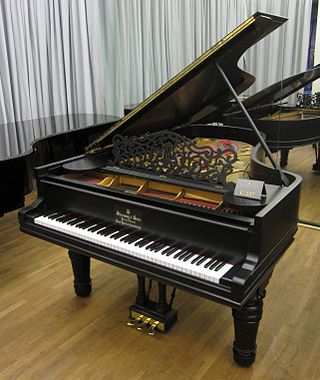
The piano is a keyboard instrument that produces sound when its keys are depressed, through engagement of an action whose hammers strike strings. Most pianos have a row of 88 black and white keys, representing each note of the chromatic scale as they repeat throughout the keyboard's span of seven and a quarter octaves. There are 52 white keys, known as “naturals”, and 36 black keys, known as “sharps”. The naturals repeat a pattern of whole steps and half steps unique to any given starting note. These patterns define a diatonic scale. The 36 sharps repeat a pattern of whole steps and minor thirds, which defines a pentatonic scale.
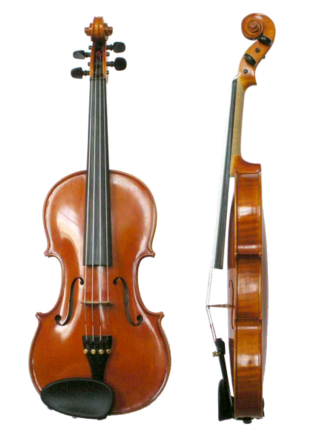
The violin, colloquially known as a fiddle, is a wooden chordophone, and is the smallest, and thus highest-pitched instrument (soprano) in regular use in the violin family. Smaller violin-type instruments exist, including the violino piccolo and the pochette, but these are virtually unused. Most violins have a hollow wooden body, and commonly have four strings, usually tuned in perfect fifths with notes G3, D4, A4, E5, and are most commonly played by drawing a bow across the strings. The violin can also be played by plucking the strings with the fingers (pizzicato) and, in specialized cases, by striking the strings with the wooden side of the bow.

In musical instrument classification, string instruments or chordophones, are musical instruments that produce sound from vibrating strings when a performer plays or sounds the strings in some manner.

The Stroh violin or Stroviol is a type of stringed musical instrument that is mechanically amplified by a metal resonator and horn attached to its body. The name Stroviol refers to a violin, but other instruments have been modified with the amplification device, including the viola, cello, double bass, ukulele, mandolin, and guitar. Johannes Matthias Augustus Stroh, an electrical engineer from Frankfurt, invented the instrument in London in 1899.

Orchestrion is a generic name for a machine that plays music and is designed to sound like an orchestra or band. Orchestrions may be operated by means of a large pinned cylinder or by a music roll and less commonly book music. The sound is usually produced by pipes, though they will be voiced differently from those found in a pipe organ, as well as percussion instruments. Many orchestrions contain a piano as well. At the Musical Museum in Brentford, examples may be seen and heard of several of the instrument types described below.
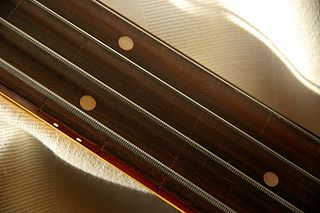
A string is the vibrating element of chordophones such as the guitar, harp, piano, and the violin family, that produces sound. Strings are lengths of a flexible material that a musical instrument holds under tension so that they can vibrate freely, but with control. This is to make the string vibrate at the desired pitch, while maintaining a low profile and sufficient flexibility to play in action.
A Parsifal bell is a stringed musical instrument designed as a substitute for the church bells that are called for in the score of Richard Wagner's opera Parsifal.

The nail violin is a musical instrument which was invented by German violinist Johann Wilde in 1740. The instrument consists of a semicircular wooden soundboard, approximately 1.5 feet (46 cm) by 1 foot (30 cm) in size, with iron or brass nails of different lengths arranged to produce a chromatic scale when bowed.

The epigonion was an ancient stringed instrument, possibly a Greek harp mentioned in Athenaeus, probably a psaltery.

A violin consists of a body or corpus, a neck, a finger board, a bridge, a soundpost, four strings, and various fittings. The fittings are the tuning pegs, tailpiece and tailgut, endpin, possibly one or more fine tuners on the tailpiece, and in the modern style of playing, usually a chinrest, either attached with the cup directly over the tailpiece or to the left of it. There are many variations of chinrests: center-mount types such as Flesch or Guarneri, clamped to the body on both sides of the tailpiece, and side-mount types clamped to the lower bout to the left of the tailpiece.

An experimental musical instrument is a musical instrument that modifies or extends an existing instrument or class of instruments, or defines or creates a new class of instrument. Some are created through simple modifications, such as cracked cymbals or metal objects inserted between piano strings in a prepared piano. Some experimental instruments are created from household items like a homemade mute for brass instruments such as bathtub plugs. Other experimental instruments are created from electronic spare parts, or by mixing acoustic instruments with electric components.

Violin acoustics is an area of study within musical acoustics concerned with how the sound of a violin is created as the result of interactions between its many parts. These acoustic qualities are similar to those of other members of the violin family, such as the viola.
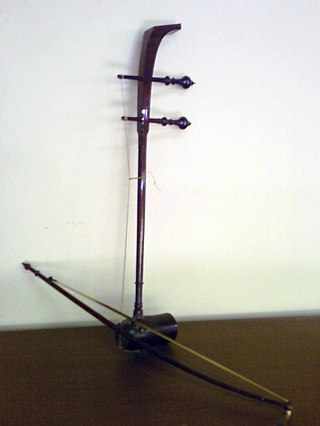
The saw duang is a two-stringed instrument used in traditional Thai music. The sound is produced by the bow made from horsetail hair which goes between the strings made from silk. The bow has to be tilted to switch from one string to another. Saw duang is light and played vertically on the lap. It creates a bright tone unlike the Saw u which produces a mellow sound. Another instrument which is similar to the Saw duang is the Chinese stringed instrument called Huqin.
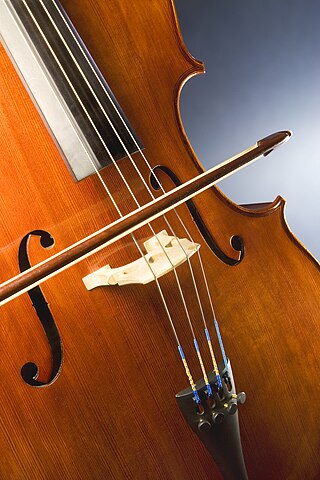
A bridge is a device that supports the strings on a stringed musical instrument and transmits the vibration of those strings to another structural component of the instrument—typically a soundboard, such as the top of a guitar or violin—which transfers the sound to the surrounding air. Depending on the instrument, the bridge may be made of carved wood, metal or other materials. The bridge supports the strings and holds them over the body of the instrument under tension.

The terpodion or uranion is a keyboard instrument which produces sound using the same friction principle as the glass harmonica.

There are several overlapping schemes for the classification of percussion instruments.